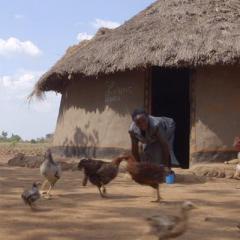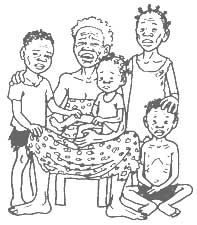Your progress
0%
Here are some of the key ideas about CBR and HIV and AIDS.
Use your mouse or keyboard to expand each of the headings below.
HIV is the virus that causes AIDS. It can be transmitted through direct contact with the blood or body fluid of someone who is infected with the virus. People may get HIV infection when they have unprotected sex or share an injection needle with an infected person. Babies can also get HIV before, during or after birth if the mother is infected.
AIDS is the final stage of HIV infection. AIDS affects the body’s immune system, making it difficult for the body to fight off diseases. AIDS can result in life-threatening infections, some forms of cancer, and deterioration of the nervous system. Not everyone who is HIV-positive has AIDS – it may be many years before people with HIV get sick with AIDS. Antiretroviral treatments (ART) can help slow the progress of the HIV virus, but they cannot cure HIV and AIDS. At the moment, prevention is the best and only cure.
Many people living with HIV and AIDS may experience disability. Antiretroviral medications help many people to live longer lives; however, this also means that they live their lives with a chronic condition characterized by cycles of illness and wellness. People living with HIV and AIDS may experience a range of temporary or permanent impairments (physical, mental or sensory), which result from treatment or from the progression of HIV. For example, common side-effects of treatment such as fatigue, digestive problems, skin problems and or neuropathy (nerve damage), may lead to functional problems such as difficulties walking, showering, driving, as well as disability for people living with HIV and AIDS.
HIV and AIDS are associated with behaviours that are often considered socially unacceptable and, as a result, people living with HIV and AIDS are widely stigmatized. These same people are frequently subject to discrimination and human rights abuses; many have been thrown out of jobs and homes, rejected by family and friends, and some have even been killed.
Sexuality
Sexuality is the way that people experience and express themselves as sexual beings, and it is an important topic when addressing HIV and AIDS. In many societies, cultural taboos limit the free discussion of sexuality issues and, in particular, many people are uncomfortable discussing them in relation to disability. However, such issues are very real in the lives of many individuals with disabilities and cannot be ignored.
People with disabilities are often perceived as asexual individuals because they are:
However, this is a myth, as many people with disabilities are as sexually active as people without disabilities, and are therefore also at risk of being infected with HIV.
Acknowledging sexuality
Research conducted in Mozambique on disability and HIV found that one reason people with disabilities are routinely excluded from HIV and AIDS policies and programmes is a refusal or reluctance to regard people with disabilities as sexual beings. The report shows this to be a further dimension of the stigma and discrimination directed towards people with disabilities.
Risk factors
The Global Survey on HIV and AIDS and Disability has shown that almost all a number of risk factors for HIV and AIDS are increased for people with disabilities.
Literacy is important for understanding HIV messages and using these messages to change HIV risk behaviours. The Education module highlights that people with disabilities generally have lower levels of education than the general population, which suggests that they could be at increased risk of HIV.
People with disabilities often have low levels of sexual knowledge and are less informed about HIV. This may be a result of missing out on HIV education at home and school because of false beliefs about their sexuality and because HIV information and messages are not presented in accessible formats.
Disabled people around the world are more likely to be victims of sexual abuse and rape than their non-disabled peers, which places them at greater risk of HIV infection.
Barriers to HIV and AIDS prevention, treatment, care and support
People with disabilities have limited access to HIV services, such as testing and counselling, medication, care and support. The barriers that people with disabilities face are similar to those outlined in the Health module, and include environmental and communication barriers such as services offered at clinics, hospitals and in other locations may having no ramps for people using wheelchairs, lacking sign language facilities or failing to provide information in alternative formats, such as Braille, audio or plain language.
People with disabilities are affected when family members have HIV and AIDS. As people with disabilities often require assistance from family members for daily activities and have extra medical, educational or rehabilitation needs, they may be neglected where there is a loss of family income, resources and time due to HIV and AIDS.
See how CBR in Uganda is assisting a woman with a physical disability who lost her husband to AIDS, and is now HIV-positive herself

It has been estimated that 4–5% of children who have lost one or both parents to AIDS also have disabilities. In these situations, they are more likely to be malnourished, neglected, placed in institutions or abandoned. Children with disabilities who are also HIV-positive are also more likely to experience exclusion and discrimination in all areas, particularly in the field of education.

Including people with disabilities in HIV and AIDS programmes and services
Many disabled people may not be included in mainstream HIV and AIDS programmes and services because it is often believed that is it too expensive or too difficult. However, there are many ways in which CBR programmes, disabled people’s organizations, HIV and AIDS advocates, educators and policy-makers can support their inclusion.
Many practical ideas are provided under Suggested activities:
Rehabilitation
Rehabilitation becomes increasingly important for people who may be experiencing disability as a result of HIV and AIDS. Rehabilitation related to HIV and AIDS can slow down deterioration and enable people to achieve and maintain independence. (see Health module.)